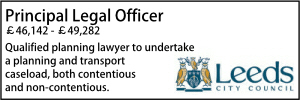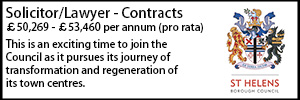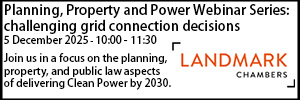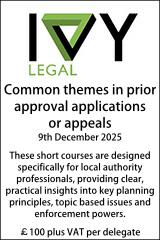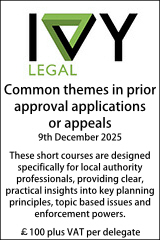In accordance with parameter plans
- Details
What does it mean to be “in accordance with” an approved plan? Daniel Kolinsky QC and Ben Fullbrook examine a recent High Court ruling.
In R (Swire) v Canterbury City Council [2022] EWHC 390 (Admin), Holgate J considered the meaning of the words “in accordance with” in a condition of an outline planning permission, requiring development to be carried out “in accordance with” various approved parameter plans.
Holgate J held that the degree of conformity required by the condition depended upon a combination of inter-related factors: the meaning of the words “in accordance with”, the nature of the plans to which the condition related, and the relationship between condition 6 and other conditions of the permission.
As to the meaning of the words “in accordance with”, Holgate J stated:
The phrase “in accordance with” in condition 6 means “in agreement or harmony with; in conformity to; according to” (Oxford English Dictionary). The dictionary examples given show that a draftsman of a planning permission may go further by adding language so that, for example, the development must be carried out “exactly” or “strictly” in accordance with particular plans. The natural meaning of the phrase “in accordance with”, taken by itself, does not connote that degree of conformity. The addition of such terms would not be tautologous. They would change the meaning of the phrase, certainly in the context of the document I have to construe.
He then considered the relevant parameter plans and found that, whilst some established clearly defined maxima, others (including the one in issue in this claim) were more diagrammatic in nature.
He went on to analyse the other conditions of the permission, reaching the conclusion that read as a whole, the parameter plans merely established broad principles, which could be departed from.
Ultimately, Holgate J found that “deciding whether a development is in conformity of in harmony with parameter plans may well involve matters of planning degree and judgment”.
In reaching these conclusions, the Judge preferred his own analysis to that suggested by the Council or the Interested Party (whose own interpretation of the condition was firmly rejected). This judgment suggests that those involved in the granting of outline planning permission should be clear about the extent to which future development is expected to accord with parameters – particularly where it is EIA development. The use of qualifying words, such as “strictly in accordance with” or “broadly in accordance with” should be considered to avoid confusion.
Daniel Kolinsky QC and Ben Fullbrook are barristers at Landmark Chambers. They represented the claimant.
Sponsored articles
Walker Morris supports Tower Hamlets Council in first known Remediation Contribution Order application issued by local authority
Unlocking legal talent
Legal Director - Government and Public Sector
Lawyer (Planning and Regulatory)
Contracts Lawyer
Locums
Poll









